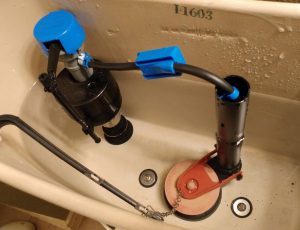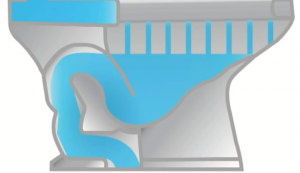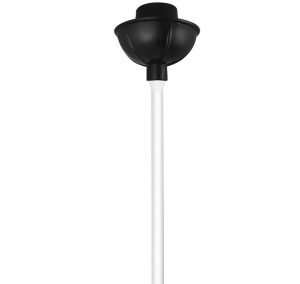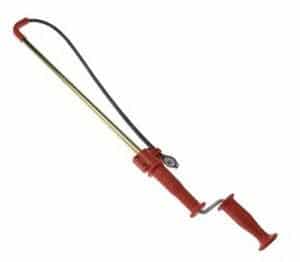How to Fix a Slow/Weak Flushing Toilet in 15 Minutes
Last Updated on August 1, 2023 by toilethaven
What Causes a Slow-Flushing Toilet?
A slow-flushing toilet can be very frustrating because, most of the time, you have to flush it twice or more times. There are many reasons why your toilet could have a slow flush, and if you can pinpoint the exact cause, then fixing it is easy.
You have a slow/weak flushing toilet because the tank’s water level is too low, the flapper chain is too slack, or the rim holes and siphon jets are clogged. It could also result from a clogged toilet drain or vent stack.
To fix a slow flushing toilet, adjust the water level in the tank to just about ½ inch below the overflow tube and ensure that the flapper chain has a slack of ¼ to ½ inch. Unclogging the toilet rim holes, siphon jet, vent stack, and drainpipe will also help the toilet have a strong flush.
If your basic toilet tank parts are older than 4/5 years, you might want to buy a toilet tank repair kit. Check out some of the best toilet tank repair kits in this post.
To fix a slow-flushing toilet, it would be really helpful for you first to understand how a toilet is designed to work.
The Toilet Tank
When you push down the flushing handle, the lift chain lifts off the toilet flapper from the flush valve opening, allowing water in the tank to flow to the bowl for flushing.
The lift chain should have a slack of about ½ inch when the toilet is not in use. If it’s too slack, it will not fully lift the flapper, so water flows slowly from the tank to the bowl.

If the water level in your toilet tank is insufficient, you will experience a slow flush. The water level in a toilet tank should be 1/2-1 inch below the overflow tube.
The overflow tube is the big tube in the middle of the tank. It sends excess water in the tank to the bowl to avoid overflowing the toilet.
The Toilet Bowl
Water enters the toilet bowl through the siphon jet, which directs water straight to the toilet opening and through rim holes found under the bowl’s rim. The water from the rim holes is mostly for rinsing the bowl.
If you live in an area with hard water, mineral deposits, especially calcium, will be deposited around these rim holes, meaning water flow to the bowl is blocked, resulting in a slow flushing toilet.
For your toilet to flush powerfully, a large amount of water must be dumped in the toilet bowl in seconds. This sudden dumping of water is what creates the siphon/sucking effect.

The flush water and the waste are siphoned at the toilet trap and flow down the sewer line through the drain pipe. If the toilet trap or drain line is partially clogged, you will also experience a slow flushing toilet.
Your toilet is vented to allow sewer gases to flow from the drain and out through the roof. If the vent is clogged, the sewer gases will build up pressure inside the vent stuck. The waste cannot freely flow out of the bowl due to the resistance created.
How can I get my toilet to flush stronger?
There are several ways to fix a slow-flushing toilet, depending on the problem. They include:
- Adjust the toilet tank water level
- Clean the siphon jet and rim holes
- Adjust the flapper chain’s length
- Unclog the toilet drain and vest stack
1. Use Hot Water and Dish soap to Unclog Rim Holes

When your toilet rim jets are clogged, which is normally the case with most slow-flushing toilets, there are several ways in which you can unclog them. Dishwashing soap is one of them.
But how do you know your toilet rim holes are clogged in the first place? Hold a small mirror under the toilet bowl rim and move it around. You should be able to see the extent to which they are clogged.
Put hot water in a bucket and slowly pour it inside the toilet bowl. Care must be taken because hot water can crack the bowl; hence the water should not be too hot. You should also pour it slowly to prevent the sudden expansion of the bowl. Hot water is more effective in dissolving and washing down the mineral deposits in the drain than cold water.
Remove the toilet tank lid and pour about 1/2 -1 cup of dish soap inside the overflow tube. Remember the overflow tube is connected to the toilet rim holes. Wait for about 10 -15 minutes, then flush the toilet.
2. Use Vinegar To Clean Toilet Siphon Jet

If the dish soap doesn’t work, try using hot vinegar. Vinegar is a mild acid and, therefore, more effective in dissolving mineral deposits. Boil about a cup of vinegar and pour it slowly through the toilet overflow tube.
The hot vinegar will eat away the minerals clogging the rim holes and the siphon jet. Before pouring the vinegar, use a sponge to remove the water at the bottom of the bowl. This way, the vinegar will unclog the rim jets and the trap. Wait for 10 to 15 minutes, then flush the toilet.
Muriatic acid (hydrochloric acid) is another product that could be used instead of vinegar. Still, we always advise people to try dish soap or vinegar first for the environment’s sake.
To prevent your toilet rim holes from clogging in the future and therefore struggling with a slow-flushing toilet, make it a habit to pour a small amount of dish soap or vinegar in the overflow tube often.
3. Plunge the Toilet

If the water is flowing out of the tank fast enough but taking longer to drain, it is most likely that your toilet drain is partially clogged. A toilet plunger will unclog a toilet effectively most of the time.
Always buy a good plunger that will properly cover your toilet outlet. Start by gently plunging to remove the air, then plunger vigorously 15 to 20 times.
Flush the toilet and check if it will flush faster and more powerfully. If your toilet is still draining the water slowly, you will need to upgrade to a toilet auger.
4. Snake the Toilet

A toilet snake, also known as a toilet auger, unclogs a toilet by shredding the clog into smaller pieces that will flow down the drain easily or pulling the clog out.
If you have a piece of towel or a bar of soap clogging the toilet, the auger will pull out the towel and break down the soap. The length of an ordinary auger is 3 to 6 feet. If the clog is further down than that, then you will need to hire a longer motorized auger or call in a plumber.
While using a toilet auger, you should always be careful not to scratch the inside of the toilet bowl. Guide the toilet auger head gently into the toilet outlet and do the same while pulling. The head has some blades and hence should be protected at all times.
To learn more about unclogging a toilet with a toilet auger, check out this post.
5. Adjust the Lift Chain
Remove the toilet tank lid and place it away in a safe place where it cannot fall off and crack. Push the toilet handle down and check if the flapper is lifting off all the way. The toilet flapper should lift to an almost vertical position.
If the flapper isn’t lifting off as designed, you will need to shorten the length of the lift chain. It may take you 2 to 3 times to get the correct length of the lift chain. The toilet lift should have a 1/2-inch slack.
While at it, ensure that the toilet handle arm moves freely inside the tank and does not touch anything.
6. Adjust the Toilet Tank Water level.
Your toilet tank will either have a float ball or a float cup. A float ball is connected to the toilet fill valve through an arm float, while the float cup is mounted alongside the body of the fill valve.
The fill valve is also connected to the water supply line from the bottom of the tank and is responsible for filling the tank after each flush. A toilet float controls the opening and closing of the fill valve and, therefore, the water level in the toilet tank.
When your toilet float is not properly adjusted, the water in the tank will be below the recommended level. As a result, this will lead to a weak and slow flushing toilet.
The water level in your tank should be about ½ -1 inch below the overflow tube. To adjust the toilet float in your tank and therefore raise the water, check this very informative guide.
7. Clean the Toilet Siphon Jet and Rim Holes
When you flush the toilet, water enters the bowl via holes under the rim or a siphon jet at the bottom of the bowl directly facing the toilet drain. Often these holes/jets become clogged by mineral deposits, especially calcium.
Flush water can not enter the bowl with the force/pressure intended, resulting in a slow flushing toilet. This can also result in the toilet drain clogging after some time.
I have written a detailed post on cleaning a toilet siphon jet and rim holes. Read it here.
8. Unclog the Vent Stack
When your toilet flushes slowly and sometimes gurgles, the toilet drain or vent is clogged. The gurgling results from the air in the vent stack escaping through the water at the bottom of the toilet.
Using a ladder, climb to the top of your house roof with a garden hose. Ask someone on the ground to open and direct the water supply inside the vent. The water’s weight will make whatever clogs the toilet fall and wash down the drain.
When the air starts flowing out of the vent stack freely, your toilet will flush faster and more strongly.
Conclusion
A slow-flushing toilet can be inconvenient, but if you know what to do, you can fix it in a few minutes. In most cases, using dish soap or vinegar will fix a slow-flushing toilet so it is not clogged.
If you have a really old toilet, buying a modern and powerful flushing tell could be what you need to do.